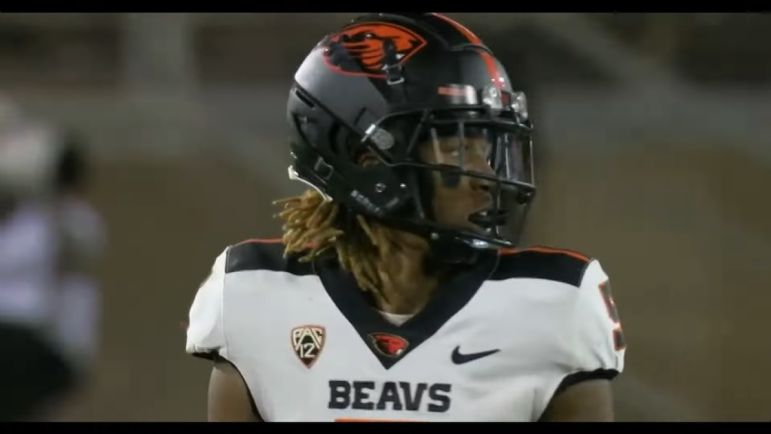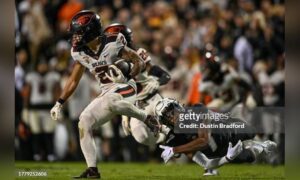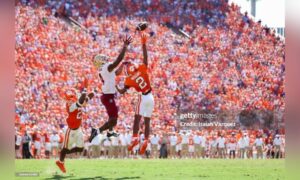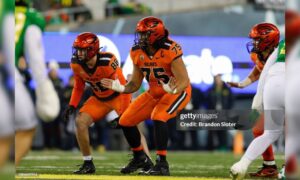From now until the 2023 NFL Draft, we will scout and create profiles for as many prospects as possible, examining their strengths, weaknesses, and what they can bring to an NFL franchise. These players could be potential top-10 picks, all the way down to Day 3 selections and priority undrafted free agents. Today, I’ll be profiling Oregon State CB Alex Austin.
#5 Alex Austin/CB Oregon State – 6’1, 195
Shrine Bowl/Combine
MEASUREMENTS
| Player | Ht/Wt | Hand Size | Arm Length | Wingspan |
| Alex Austin | 6’1, 195 | 8 1/2 | 31 7/8 | N/A |
| 40-Yard Dash | 10-Yard Dash | Short Shuttle | 3-Cone | |
| 4.55 | 1.54 | 4.33 | DNP | |
| Broad Jump | Vertical | Bench Press | ||
| 10’2″ | 33 | DNP |
The Good
— Has smooth footwork in press coverage, is able to easily match receivers releases laterally before flipping his hips to transition
— Transitions well to carry vertically from his backpedal in off-coverage
— Willing open field tackler who can effectively tackle the catch to limit YAC opportunities
— Disciplined in his run fits, both in crack/replace and when asked to play as an overhang defender vs nub TE sets
— Appears to have a solid foundational understanding of zone coverage responsibilities and opponents route concepts, midpoints route concepts and plays high to low well
— Has nice plant and drive mechanics from off-coverage when able to stay square
— Does a nice job to work off of his post safety, force inside releases, and get sticky to the low shoulder in Cover 1
— Twitchy athlete with solid foundational change of direction ability
— Sinks his hips and breaks well from a crossover run, allowing him to effectively break from bail technique in zone coverage assignments
— Does a phenomenal job of closing to the top shoulder and working to get chest to chest to content back shoulder fades and jump balls
— Solid ball skills when playing from in phase at the catch point, plays the pocket with physicality and has a nice feel for when to high-point when in location with the receiver
The Bad
— Pad level tends to rise a bit when his cushion is threatened in off-coverage
— Has a tendency to open hips prematurely in off-coverage, creating room for receivers to work across his face
— Must show more effort and fight to disengage from stalk blocks on the perimeter
— Tends to aim low and can fall off tackle attempts against larger framed players, rarely generates knockback on contact
— Can be somewhat passive when triggering vs wide receiver screens on the perimeter
— Below average hip mobility, struggles to flip hips and transition laterally once his cushion is threatened
— Does not possess high-end long speed to recover and close to the catch point when playing from out of phase
— Shows little, if any physicality in the release phase. Mirror press is a great primary option, but he needs to add variance and get physical at times, particularly as he is lacking long speed
Bio
— 140 tackles 2 TFLs 1 sack 3 FRs 4 INTs 24 PDs 1 TD
— 2022: 57 tackles 1 TFL 1 sack 1 FR 2 INTs 12 PDs 1 TD
— Declared for the draft following his 2022 redshirt sophomore season
— 2022 All-Pac-12 Honorable Mention
— 2021 All-Pac-12 Honorable Mention
— Averaged 29.5 yards per return on his four collegiate interceptions
— Standout high school sprinter, competed in the 100 and 200 meter dash for Long Beach Poly High School
Tape Breakdown
In my evaluation of Rejzohn Wright, who is certainly one of my top cornerbacks in this year’s class, I came away impressed with the Oregon State defense, a well coached group that plays sound coverage, rallies to the football, and tackles well as a unit. Likewise, I decided to take a look at Wright’s running mate over the past two seasons, that being fellow cornerback Alex Austin.
While not quite possessing the length of his counterpart, Rejzohn Wright, Austin is blessed with solid measurables in his own right, with the necessary frame to challenge receivers in their release phase at the line of scrimmage. Likewise, when playing from in phase, Austin’s length allows him to disrupt the catch point and prevents him from being boxed out by larger framed receivers.
In press coverage, Austin consistently shows high level footwork, working to mirror receivers at the line of scrimmage, staying square and forcing them to declare before engaging his off-hand jam. Here, working in press coverage, Austin does a nice job of staying square and mirroring the receiver in his inch technique, matching the outside release before opening to transition and carry, closing to the upfield shoulder, working to get chest to chest, turning through the receiver to locate the football, and high pointing the ball for a pass breakup.
In the redzone, corners must turn into the receiver to protect against jump balls and back shoulder balls, as throws come out much quicker with less space to travel in the air. Overall, Austin’s consistency in technique allows him to be effective in press coverage despite his lack of physicality in the release phase.
When able to close to the catch point, whether from press or off-coverage alignments, Austin’s arm length and precision allow him to effectively contest the catch point, both while closing from in or out of phase. On the first rep, working in press-coverage against Boise State, Austin once again works his inch tech to mirror the receiver in his release phase, contacting the upfield shoulder as the receiver declares inside on the slant route, staying in phase, and extending his off-arm across the receivers body to secure the pass breakup.
On the next rep, playing this time from an off-coverage alignment to the backside of a 3×1 set, Austin weaves to maintain his inside leverage at the snap, breaking downhill as the receiver declares inside on the bang post (“glance route”), this time using his length to leap and extend over the top to disrupt the pocket, once again breaking up the pass. When able to effectively close to the catch point, Austin certainly possesses the necessary ball skills to compete at the catch point at the next level.
As a tackler, Austin does a nice job both in the box and in the open field to trigger effectively and bring physicality to the point of contact. While his technique is always perfect, it is easy to appreciate the toughness and desire to initiate contact that he plays with.
On the first rep, Austin does a nice job, working as the flat defender, to pass off the curl route to the hook/curl defender with an “in” call, expanding to play top down and keep leverage as the running back expands to the flat. As the quarterback’s shoulders declare lateral, Austin plants and triggers downhill, closing ground rapidly, taking a proper angle, and knifing through the backs lower half for an effective leg tackle.
On the next rep, this time playing as the overhang defender, aligned 3×6 outside of a condensed bunch formation, Austin keys the backfield action post snap, taking a false step inside before working laterally to match the quarterback toward the sideline. Closing at a proper angle with inside leverage, Austin accelerates through the near hip, leaving his feet to deliver a physical strike, and drop the quarterback well short of the sticks. While his tendency to drop his head and aim low can certainly cause misses, his desire to trigger and get impose physicality on opponents is something that can’t be taught, and could help him become a solid special teamer at the next level.
My primary issue with Austin tape is his consistent inability to stay square in off-coverage, where his tendency to play on his heels causes him to panic when receivers break his cushion. This often stems from a lack of self-confidence in one’s long speed and ability to carry receivers vertically.
Nonetheless, with below average hip mobility and fluidity in movement, Austin is often unable to recover when receivers generate separation across his face. Here, working in off-man coverage, Austin gets caught in no man’s land at the snap, pedaling from four yards depth, allowing the receiver to threaten his cushion immediately.
As the receiver begins to step on his toes, Austin opens into his crossover run, allowing the receiver to easily break across his face and generate plenty of separation for an uncontested pitch and catch. Ultimately, Austin needs to work to stay square and gain comfortability in contesting deep balls from out of phase to succeed at the next level. Deep shots down the sideline are low percentage throws that defense’s want to force at any level, whereas intermediate targets over the middle of the field are arguably the highest percentage throw in football.
Any defensive back, even the best in the game, are going to open prematurely at times when their cushion is broken. It becomes an issue when it becomes a default habit to the point where the player is working ways to compensate for the habit. Due to his lack of confidence in his ability to carry vertically, and thus his inability to stay square at the top of routes, Austin tends to be a bit over reliant on his speed turn.
Once again working from off-coverage, Austin initially shows solid patience, keying the quarterbacks drop for a quick game, three-step read, but immediately feels his cushion threatened and resorts to opening his hips toward the sideline. Out of phase to contest the receivers inside break, Austin is forced to speed turn, leaving him unable to adequately close to the top shoulder.
As I mentioned earlier, while it is easy to appreciate the physical edge and aggressiveness that Austin plays with in coverage, his tendency to leave his feet on contact causes him to slip off tackles at times. Here, aligned from depth to a nub tight end set, Austin keys the backfield action and triggers downhill to match the quarterback toward the sideline.
After a false step, Austin effectively closes to the near hip, but leaves his feet at the point of contact, allowing the quarterback to easily extend an arm into his facemask and break the tackle. While most corners tend to have similar issues as tacklers, ideally you would like to see Austin take one more step here, where instead of needing to lunge, he can step on the ball carriers toes, bring his hips with him, and hit on the rise at the point of contact to ensure the tackle is made short of the sticks.
Conclusion
Overall, I do think Austin will find his way onto a roster and compete for snaps as a special teamer, serving as a depth piece in the secondary. His fearless approach as a tackler and ability to play decisively should make him a serviceable special teams player. As far as cornerback snaps are concerned, until he is able to become comfortable with staying square to contest shallow and intermediate in-breaking routes, he will not be able to survive in a man-match quarters scheme, which most teams at the NFL deploy at a healthy rate.
In zone coverage, Austin has a nice feel, playing routes top down and occupying throwing windows to force checkdowns. Likewise, his ability to stay square and squeeze receivers into the sideline from the top shoulder should translate well in his press coverage reps, although he will need to develop more variance in his approach, showing more physicality in the release phase to disrupt timing. In a scheme that relies heavily on press-man coverage, along with traditional spot drop zone coverage as opposed to man-match quarters schemes, where the bulk of Austin’s struggles arise, he has potential to find a serviceable role in the secondary.
He reminds me quite a bit of Thomas Graham Jr., who I evaluated out of Oregon a couple years back, and has floated around the league, bouncing back and forth between practice squads and gaining some spot starts with the Bears and Browns. In my eyes, both players possess great ball skills, but lack the hip mobility to consistently stay in phase from off-coverage in man match schemes at the next level. A far better tackler than Graham, however, I do believe Austin has the potential to serve as an impact special teamer at the next level, with the potential to develop as a corner if he can refine his technique and play with far more patience.
Projection: Mid to Late Day Three
Depot Draft Grade: 6.7-Backup/Special Teamer (5th Round)
Games Watched: vs USC (2022), at Utah (2022), at Washington (2022), vs Boise State (2022)








